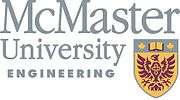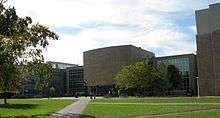McMaster Faculty of Engineering
The Faculty of Engineering at McMaster University in Hamilton, Ont., is known for innovative educational programming, such as its five-year engineering and management program,[1] and for its research and engagement with industry[2] and community. Established in 1958, its institutes, centres and laboratories have collaborated on numerous research projects with the public and private sectors. It has the distinction of being the first engineering program to have included problem-based learning into its teaching, importing it from the McMaster University Medical School where it was first developed.[3] The Faculty is home to 1 Canada Excellence Research Chair, 13 Canada Research Chairs, 4 Natural Sciences and Engineering Research Council chairs, and 14 Endowed Chairs.[4]
The John Hodgins Engineering Building remains the major teaching, research, outreach and administrative hub on campus for the Faculty of Engineering | |
| Type | Faculty |
|---|---|
| Established | 1958 |
| Affiliation | McMaster University |
| Dean | Ishwar K. Puri |
| Students | 5,500 |
| Location | , , |
| Website | Faculty of Engineering |
 | |
Programs
The faculty offers a full range of undergraduate and graduate, including research-intensive doctoral degree programs, across seven departments in various engineering disciplines, including chemical engineering, civil engineering, computing and software, electrical and computer engineering, engineering physics, materials science and engineering and mechanical engineering.
The B.Eng. undergraduate programs are accredited through the Canadian Engineering Accreditation Board. All undergraduate students take a common first-year program, which provides a solid foundation in the fundamentals of engineering disciplines. At the end of the first year, students choose one of fourteen program disciplines, including five-year programs such as Engineering & Management, Engineering & Society, or streams in Integrated Biomedical Engineering and Health Sciences.
Graduate programs in biomedical engineering are offered through the School of Biomedical Engineering, and graduate engineering practice programs through the Walter G. Booth School of Engineering Practice.
The joint McMaster-Mohawk Bachelor of Technology program offers four-year bachelor-degree programs in engineering technology, including process automation technology, biotechnology and automotive and vehicle technology, as well as degree-completion programs in civil engineering infrastructure technology, computing and information technology, energy engineering technology and manufacturing engineering technology.
History
In 1956, McMaster named its first Director of Engineering Studies – Dr. John W. Hodgins, a Chemical Engineering professor from the Royal Military College – to develop a full engineering program for the university. The program was approved by the McMaster University Senate on February 1958. The engineering building, now John Hodgins Engineering Building, officially opened a few months later. The first class of 25 students graduated in 1961.

Five departments were established in the first two years – Chemical, Civil, Electrical, Mechanical and Metallurgical Engineering — and, later, Engineering Physics joined them. The first engineering degrees from McMaster were Master of Engineering (M.Eng.) degrees, with the first ones awarded in 1959. The first doctoral degrees (Ph.D.) were awarded in 1965.
The undergraduate programs grew in step, and by 1972, over 100 engineers received their (Bachelor of Engineering) B.Eng. degrees, with the annual total passing 200 by 1980, and in 2014 this number equalled 588. The year 1971 marked the start of the Engineering and Management program and later that decade, the Engineering and Society program began. In the early 1980s, the Electrical Engineering started its unique Computer Engineering program, and Mechanical Engineering began its program in Manufacturing Engineering.
The Faculty of Engineering began joint faculty appointments, research associates and collaborative research activities with McMaster's Faculty of Health Sciences. Courses in Biomedical Engineering were offered as electives in all engineering programs.
In 1997, the Faculty of Engineering began a joint venture with the Department of Engineering Technology at Mohawk College and created the Bachelor of Technology program.
Motivated by the need to “prepare students to be flexible in a rapidly changing world and to meet challenges not yet imagined”, in 2019 the Faculty announced the most significant transformation in the sixty year history of engineering education at McMaster University through The Pivot, where design thinking, an innovation mindset and entrepreneurship are embedded in all programming.[5] The three pillars of The Pivot are (1) changing the curriculum by seamless, project-based learning experiences; (2) reimagining the classroom by creating purpose-built studio spaces that replace lecture halls; and (3) amplifying experiential learning by offering more extracurricular and research opportunities to students.[6]
Vision
The Faculty of Engineering at McMaster University will be known internationally as a leader in research and education supporting the development of engineering practices for a sustainable and prosperous world.[7]
Ranking
The 2017 ShanghaiRanking’s Global Ranking of Academic Subjects[8] ranked the Faculty’s civil engineering program 29th in the world, and metallurgical engineering, computer science and engineering, and transportation science and technology programs within the top 75 around the globe. Also rated within the top 101-150 programs in the world were the Faculty’s water resources and telecommunication engineering disciplines.[9]
Deans of Engineering
Since the strong founding vision of John W. Hodgins, the Faculty has enjoyed equally strong leadership and an organized succession through its deans.
| Dean | Years served |
|---|---|
| Ishwar K. Puri | 2013-present |
| David S. Wilkinson | 2008-2012 |
| Mo Elbestawi | 2001-2007 |
| Mamdouh Shoukri | 1994-2001 |
| Gary R. Purdy | 1989-1994 |
| Arthur C. Heidebrecht | 1981-1989 |
| John W. Bandler | 1979-1981 |
| Leslie W. Shemilt | 1969-1979 |
| John W. Hodgins | 1958-1969 |
Student life
The Faculty of Engineering at McMaster is known for its active student life. The McMaster Engineering Society (MES) is the student-run organization dedicated to fostering "the development of well-rounded undergraduate engineering students through accessible support of academics, athletics, and recreational and professional activities while maintaining the integrity and unique traditions of our faculty society." The MES offers an Engineering Co-op and Career Services (ECCS), which is a joint venture with the Faculty of Engineering. Engineering Co-op & Career Services connects students with employers, provides career-planning tools and resources, and provides opportunities for students to gain employment experience.
McMaster Engineering, due to its emphasis on experiential and problem-based learning through extracurricular activities, also encourages a rich range of student organizations. Engineering students join, for instance, McMaster EcoCar 3, McMaster Formula Electric, Engineers Without Borders, McMaster Engineering Musical, McMaster Baja Racing and the McMaster Solar Car Team. These student clubs are created and fully managed by McMaster Engineering students.
Traditions
Engineering students at McMaster University can purchase leather jackets with their faculty and graduation date embroidered on the arms and back of the coat. Since this tradition was established, these jackets have become a distinctive characteristic of McMaster Engineering on campus.[10]
Student representatives to the faculty are chosen each year to lead the upcoming first years and represent the faculty of engineering at events. They typically dress in a red jumpsuit which they often personalize throughout their stay at McMaster Engineering. These representatives, nicknamed "Redsuits" or "Reds" are a fixture on campus and are known for their spirited behaviour. The Redsuits have become synonymous with McMaster Engineering as well as McMaster University.
Undergraduate students produce an annual Engineering Musical every March that is written and directed by engineering students, with all of the 20-30 member cast and 10-15 member crew consisting of engineers. It incorporates a talented band that arranges the musical score for drums, guitars, banjos, accordions, trombones, trumpets, flutes, keyboards, saxophones, clarinets, and various percussional instruments. The musical takes a well known play, theme, or story and uses it as inspiration, but with a new script that includes jokes about professors, courses, faculty, and "arties".[11]

The fireball
The fireball is the official symbol of McMaster Engineering. It historically comes from the coat of arms of Hamilton College. McMaster's Faculty of Engineering emerged from Hamilton College in 1958 and hence adopted a red fireball as its own emblem in 1960.[12] The fireball symbol is used widely by both the faculty and students to represent everything from culture, to excellence in research and innovation, as well as the energy that cuts across science and engineering.[13]
Facilities
Over the years, the Faculty of Engineering has expanded its facilities to meet the growing needs of both its undergraduate and graduate students. The faculty's facilities now include:
- John Hodgins Engineering Building, which with 240,677 sq/ft (22,360 sq/m) is the major teaching, research, outreach and administrative hub on campus for the McMaster University Faculty of Engineering.
- Information Technology Building – 82,000-square-foot (7,600 m2) building, home to the Department of Computing and Software and the Department of Electrical and Computer Engineering.
- Communications Research Laboratory
- Applied Dynamics Laboratory – research lab for Department of Civil Engineering
- Thode Library of Science and Engineering
- Nuclear Research Building, McMaster Nuclear Reactor
- McMaster Manufacturing Research Institute – 10,000-square-foot (930 m2) addition to the Engineering Building
- Engineering Technology Building - 125,000-square-foot (11,600 m2) building houses the Walter G. Booth School of Engineering Practice and Technology and School of Biomedical Engineering
- Gerald Hatch Centre for Engineering Experiential Learning (Anticipated Occupancy – Start 2017)
The world's most advanced microscope
The Canadian Centre for Electron Microscopy at McMaster is home to the world's most advanced microscope. The titan 80-300 cubed microscope has a magnification of 14 million and is used for material, medical and nano-research.
Schools and Departments
School of Engineering and Applied Sciences (SEAS)
Engineering Departments with Undergraduate (B.Eng.) and Graduate Programs (Master's and Ph.D.)
Five-year undergraduate engineering programs (B.Eng.)
Walter G. Booth School of Engineering Practice and Technology
Walter G. Booth made a generous donation of an unknown amount. Walter was the owner of TigerCat in Woodstock Ontario. Walter took an untraditional route through the education system and completed a masters of engineering at McMaster University. Walter has family in Woodstock Ontario to this day.
Interdisciplinary Graduate Schools
References
- "McMaster University > Engineering and Management"
- "Siemens provides McMaster with $458M software grant for product design and development"
- Problem-Based Learning (PBL)
- "Chairs". McMaster University Faculty of Engineering. 2018. Retrieved 2018-04-29.
- The Pivot | Faculty of Engineering, McMaster Engineering website.
- The Pivot: Transforming engineering education, McMaster Engineering website.
- Innovation from Excellence
- Global Ranking of Academic Subjects
- McMaster Engineering ranked among the world's best
- Leather jacket sale
- Musical | McMaster Engineering Society
- What is the fireball?
- Traditions | McMaster Engineering Society Archived 2013-10-08 at the Wayback Machine